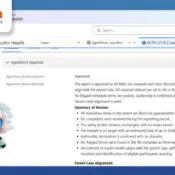Configuration vs. Customisation for Salesforce

In order to maximise the potential of Salesforce and make it work harder for you, two options are available: configuration and customisation. Theoretically, Salesforce could be used just the way it is, but that would be like using a smartphone just to make phone calls. You would probably be missing out on a few features.
- Configuration versus Customisation
- Declarative versus Programmatic
- Click versus Code
What is configuration?
“Configuration” refers to the gigantic realm of things that you can do through point-and-click administration. Salesforce has been elected most innovative company in the world 4 years in a row because they’ve brought customers an impressively flexible platform, which offers a wide range of configuration tools ranging from creating custom fields on any objects, enforcing data quality through validation rules, creating formula fields and rollup summaries, creating data reports in a matter of clicks, configuring workflows to automate actions like task creations, emails, field value updates, managing security and data sharing through profiles and roles, etc. All this in a very intuitive and user-friendly fashion.
Configuration is a fast, straightforward and easily maintainable way to make Salesforce do more for you.
What is customisation?
“Customisation” is a term that means code is required. If for some reason what you try to achieve is not feasible with configuration, you will need to add some lines of code to make it happen. Salesforce offers a language (Apex) and a platform (Force.com) for developers to program whatever was not included in the out-of-the-box features. When you start coding, the sky’s the limit.
A few examples of customisations are:
- Apex triggers: automate complex actions to be executed upon certain operations
- Visualforce pages: display information on the screen in a different way than the standard Salesforce look and feel
- Real-time integration: push your information to another system every time you update a record
Customisation is a great way to automate complex business scenarios that can’t be achieved with point-and-click configurations.
Customised solutions require technical knowledge, tend to take longer to implement and are more complex to maintain.
Which one is right for me?
Obviously configuration is recommended if what you are looking for is achievable with Salesforce administration tools. But that’s not always the case. Either because you don’t know how – with 3 releases a year, it’s hard to keep up with all the features Salesforce provide to their customers. Or, because your requirement is too complex and you need customisation. In the latter it’s very important to get it done properly by an experienced professional. The last thing you want is your powerful Salesforce tool to be corrupted by some dodgy coding.
If you want Salesforce to do more and you’re not sure how, don’t hesitate to contact us. We’ll be more than happy to help you out.














